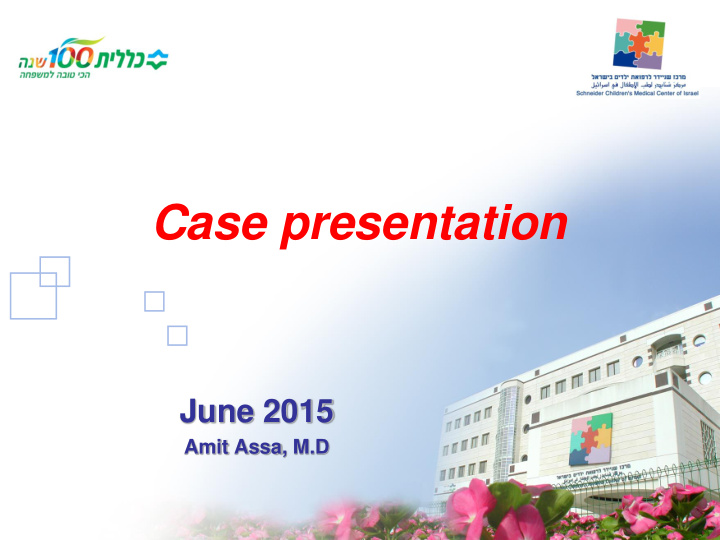



Case presentation June 2015 Amit Assa, M.D
Disclosure Some constipation from time to time
Based on a true story… 12 months old boy with 4 weeks of rectal bleeding 9 months of 5-8 soft-watery stools Dropping percentiles….( 25% to 3%) Normal diet (previously, no response to diary withdrawal)
Case History Pregnancy and delivery: Term, BW 3300, no complications At 2 months: Bi-lateral cervical lymphadenitis (fever, CRP, ESR) Aspiration from lymph node: Serratia Marcescens Resolution under Resprim and Cefuroxime Bone marrow tap- normal Infectious serologies for EBV, CMV, HIV: Negative Immunoglobulins- Normal CBC- normal (WBC 20,000-30,000, normal differential) No other infectious events Normal development
PE+ Labs. CBC- leukocytosis Hb- 8.5, MCV- 64, RDW-18 CRP- 3 mg/dl ESR- 74 Albumin- 3.6 No peri-anal Stool cultures, O&P, CDT- negative findings
What is the probable diagnosis?: a. Very early-onset IBD b. Some kind of immune deficiency c. Milk protein allergy d. A pediatric gastroenterologist’s problem - I don’t care
What is the probable diagnosis?: a. Very early-onset IBD b. Some kind of immune deficiency
VEO-IBD Disease onset < 6Y 4-10% of pediatric IBD Colonic predominance, 20% IBD-U 1 No clear evidence of enhanced aggressiveness/ complications 2 Family Hx DD with immune deficiency syndromes (SCID, CVID, hyper IgM syn. ...) 1 Prenzel et al . JCC 2009 2 Benchimol et al . Gastroenterology 2014
Group Classification Age range ( y ) Pediatric-onset IBD Montreal A1 Younger than 17 EOIBD Paris A1a Younger than 10 VEOIBD Younger than 6 Infantile (and toddler) onset Younger than 2 IBD Neonatal IBD First 28 days of age Uhlig et al . Gastroenterology 2014
Specific IBD-like Immune deficiency syndromes Chronic Granulomatous disease Wiskott-Aldrich syndrome Immune dysregulation-Polyendocrinopathy- Enteropathy-X linked (IPEX) syndrome Glycogen Storage Disease type 1b nuclear factor κB essential NEMO deficiency modulator protein (X-linked) Hermansky-Pudlak Syndrome
Overlap between IBD and IBD-like Immune deficiency syndromes Approximately 50 monogenic disorders Granulocyte dysfunction: defects in oxidative burst (including SNPs in P40 phox and P67 phox ) 1,2 Apoptosis defects: Mutations in X-linked inhibitor of apoptosis protein gene ( XIAP ). Associated with EBV driven HLH Epithelial barrier defects: ADAM17 deficiency T and B cell defects 1 Rioux et al . Nat Genet 2007 2 Muise et al . Gut 2012
Overlap between IBD and IBD-like Immune deficiency syndromes IL-10 defects (IL-10, IL-10RA, IL-10RB) Infantile colonic IBD Severe peri-anal involvement Refractoriness to conventional therapies Risk for intestinal B-cell lymphomas 100% penetrance Treatment: HSCT
Uhlig et al . Gastroenterology 2014
So, what do we most probably have here? Polygenic IBD Monogenic IBD ( IL10 pathway…) Chronic Granulomatous disease Wiskott-Aldrich syndrome Immune dysregulation-Polyendocrinopathy-Enteropathy- X linked (IPEX) syndrome Glycogen Storage Disease type 1b Hermansky-Pudlak Syndrome
So, what do we most probably have here? Polygenic IBD Monogenic IBD ( IL10 pathway…) Chronic Granulomatous disease Wiskott-Aldrich syndrome Immune dysregulation-Polyendocrinopathy-Enteropathy- X linked (IPEX) syndrome Glycogen Storage Disease type 1b Hermansky-Pudlak Syndrome
Back to the patient Colonoscopy NBT NOBI Absence of P91 , CYBB mutation, mother and sister are carriers
Chronic Granulomatous Disease 1:200,000 live births 1 Defects in the phagocyte reduced nicotinamide adenine dinucleotide phosphate (NADPH) oxidase ( phox ) complex Genetic mutations in all 5 components of the complex Rec. infections (lung, skin, lymph nodes, liver, bone) Typical organisms: S. aurus, B cepacia, S marcescence, Norcardia Sp., Aspergillus Sp. Wolach et al . Clin Immunol 2008
Chronic Granulomatous Disease 40%-50% of patients develop CD-like intestinal inflammation Survival depends on residual superoxide production Histology- granulomas and pigmented macrophages Prophylaxis: Trimethoprim/sulfamethoxazole, Itraconazole Survival into adulthood: 90% Serious infections rate: 1/3-4Y
CGD intestinal manifestations Gastric outlet obstruction (15%) Intestinal inflammation (40%). Third fails medical therapies High rate of peri-anal disease Liver abscess (35%) Holland SM. Hematol Oncol Clin North Am 2013
How would you not treat the colitis in this patient? a. Corticosteroids and then 5-ASA b. Corticosteroids and then thiopurines c. Anti TNF α agents d. Anti IL-1 agents e. Diversion ileostomy f. Allogeneic HSCT
How would you not treat the colitis in this patient? a. Corticosteroids and then 5-ASA b. Corticosteroids and then thiopurines c. Anti TNF α agents d. Anti IL-1 agents e. Diversion ileostomy f. Allogeneic HSCT
CGD treatment of intestinal disease The cornerstone for remission induction: corticosteroids (CS) CS should be tapered down slowly 5-ASA maintenance is effective in a subset of patients Other therapeutic options: Thiopurines (few reports) 1 Cyclosporine (one report) IL-1 receptor blockade (Anakinra- one report) 2 Diversion ileostomy (2/8 responded) 3 Colectomy (5/5 responded) 3 Definite treatment: Allogeneic HSCT 1 Marks et al . Am J Gastroenterol 2009 2 De-Luca et al . PNAS 2014 3 Alvarez-Downing et al . Dis Colon Rectum 2013
When to suspect monogenic IBD YOUNG AGE YOUNG AGE onset MATTERS Severe Multiple family Thriving Endocrine perianal members and failure concerns disease consanguinity Treatment Recurrent Autoimmunity failure infections MOST Macrophage Skin lesions, Obstruction activation dental\hair and atresia Tumors syndrome abnormalities of intestine and HLH
Searching for monogenic IBD/IBD like disease
Back to the patient Steroid dependent Need for recurrent transfusions Failed maintenance with 5-ASA and Azathioprine Awaiting Anakinra approval Considering diversion ileostomy
Recommend
More recommend